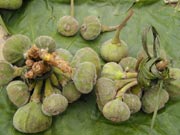 |
|
Ficus Bees in Mutual Survival with Ficus Trees |
The honey and pollen in the flowers of plants provide delicious foods for insects; while insects also pollinate for the plants in the process of seeking foods; and this is a supplementary relation in-between many plants and insects in the biological field. However, many plants and insects are not exclusive in such relations, i.e. the flowers of one kind of plant can provide foods for many kinds of insects, and one kind of insects can also pollinate for many kinds of plants. In the rain forests, the supplementary relation in-between plants and insects is also varied in forms. A kind of small shrub,
Rauvolfia yunnanensis, contains reserpine, which is a kind of medicine for treating high blood pressures; the tube-like flowers of
Rauvolfia yunnanensis are very small and have wools in the inner cavity of the tube. The hole of the tube is so small that only small ants can crawl into it and pollinate for the plant. But that kind of small ants does not rely on
rauvolfia yunnanensis for survival only, and their supplementary relation is actually only partly exclusive. In the rain forests, various ficus trees and insects have exclusive supplementary relations; that's to say, their relations are undivided.
 |
|
Fruits of the Eared Strangler Fig
(Ficus auriculata Lour.) |
In the rain forests of Xishuangbanna, there are many varieties of ficus, such as ficus
altissima, F. racemosa, and F. auriculata etc.; they are all members of the ficus family. Their flowers, besides male and female flowers, also include a kind of wart flower. Sometimes, the male flowers and female flowers grow on different plants. The anthotaxy of ficus is the most peculiar in all plants, some anthotaxies are round, some are elliptical, and some look like pears; the flowers grow densely and have inner walls in their anthotaxies. Looking from outside, people can not find their flowers; so people who do not know them well tend to believe that they are "fruits without flowers"(or fig). When the flowers are in blossom, the channel on top of the anthotaxies will open to let a kind of ficus bees in to pollinate for them. Since the structure and the growing habit of the ficus anthotaxies are quite peculiar, only this kind of special insect can pollinate for them. The ficus tree can not grow out of any fruits or will become distinguished without the small bees; in the same time, these special insects also spend most of their life time in the anthotaxies of the ficus trees; and they can not survive without ficus trees. That's to say, ficus trees and these insects rely on each other for survival, and they are in exclusive supplementary relations. Using a scientific term, the relation is called "co-evolvement". Such complicate and fine-drawn relations in-between plants and insects are quite outstanding in the tropical rain forests. The fine-drawn relationship between ficus trees and ficus bees has developed to a very high stage and has established quite exclusive relation of a co-surviving nature. According to our studies, many ficus trees can only let a special kind ficus bee to pollinate for them, or we can say, there are more than 1500 varieties of ficus trees in the world and there must be also hundreds of varieties of ficus bees. No matter what side is threatened among them, the corresponding side will also be affected; so, if we want to protect the biological species, the critical point is to protect the environment and the ecological system around them.
Regarding the ficus bees which rely on each other with ficus trees, we have gotten to know five types of them; these insects are very small in shape, with a body length of 0.15-3 mm; the male bees are smaller, they have no wings and they spend their whole life in the anthotaxy cavities; the female bees are black, and they will crawl out of the anthotaxy after mating with the male bees, who will try to find wart flowers to lay eggs in other anthotaxies, thus, will complete the process of pollination for the plant they rely on too. The delicate relations in-between the ficus trees and ficus bees give us a chance to comprehend the secrets of the rain forests; and the rain forest is really an nature-endowed heavenly book, human beings can learn boundless knowledge from them.
 
|